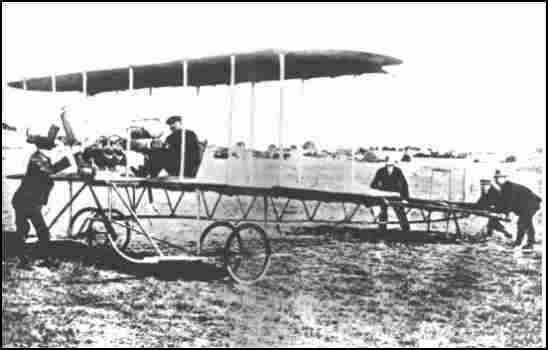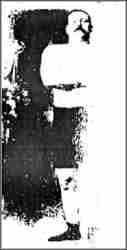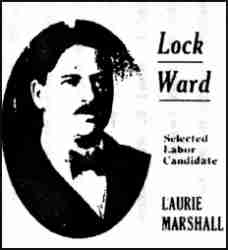
1884-1966 |
 |
Here is a photo of a little-known pioneer Australian aviator, Laurie Marshall, with the biplane that he built here in Melbourne in about 1911. It's not known for certain whether he succeeded in flying it, but he experimented with it until he went bankrupt, and the engine is now in a museum. This is the only known photograph of the Marshall aeroplane still in existence. This carefully posed shot shows Marshall at the controls, Wally Henderson swinging the prop, and Sidney Panther, extreme right at the tail. An enlargment of this photo was hung for many years in the Collingwood Town Hall. |
|
by Jim Fullarton From: "Airsport" Journal of Sport Aircraft Association of Australia April, 1984 Part of the prize money was expected to be provided by private subscription, and a further requirement was that all intending entrants had first to give evidence of their capabilities before being officially accepted as competitors. The selection process finally settled on a field of 21 would-be-aviators, amongst them being a young resident of the Melbourne suburb of Fairfield by the name of Laurie Marshall. By all accounts, Mr. Marshall was no ordinary citizen. Of impressive physique, he was an all round athlete who had participated with success in weight lifting, wrestling, hockey and cycling. On one occasion, at a stage performance by the famous strong man, Hackenschmidt, he won a prize of ten golden sovereigns for lifting a huge bag of flour which had defied the efforts of all previous contenders. When the Boer War had broken out in 1899, he had been too young to enlist as a soldier, but managed to get accepted as a farrier, on the strength of some part time experience as a blacksmith's striker, thus gaining the distinction of being the youngest recruit from Victoria to serve in that campaign. He later transferred to the Victorian Mounted Rifles as Trooper No. 100, but his experiences during the war, and in particular, what he saw of the treatment of Boer civilians, brought him to the conclusion that war had a brutalising effect on all concerned, and in later life he was to adopt a strong anti-war stance. While in South Africa he came under another influence which was to have a profound effect on his subsequent career. Hours of observing the flight of vultures soaring over the Veldt aroused in him an absorbing interest in the possibilities of flight, and not long after his return to Australia, he made some experiments with a glider. This was in the period 1904-5, only a year after the Wright brothers, but unfortunately, no record of these experiments has survived. When he entered for the competition in 1909, Laurie Marshall appeared to be well set up in life, with his own house and butchery business, but all that was to change, as his bold incursion into the infant science of aeronautics was to result in complete financial disaster. It is for this reason that not a great deal of information about the aeroplene is available. As his son, also named Laurie explans, "Father's Aeroplane" was not a popular subject in the Marshall houshold, and any discussion about it was definitely not encouraged. What is known is that it originally used an engine made my Mr. Aubrey Locke, who for many years ran a garage in High Street Armadale, (Vic.) and, in fact, the engine was still on the premises in the 1960's when it was inspected by Keith Meggs, to whom I am indebted for details of its construction. In one respect, it was of very prophetic design, being an air cooled flat four such as is used on the majority of today's light aircraft. Unfortunately, it had some major defedfts, which gave Marshall a lot of trouble, and eventually led him to reject it. The cast iron cylingers were bolted to the crankcase by a flange at their base, and this apparently, was not quite up to it, as every now and then it would blow a pot right off. Furthermore, it was a difficult casting to replace, and on one occasion they had to make no less than 40 attempts before getting a sound casting. In addition, it failed to give the design HP, althought his was not an uncommon failing in those days. Construction of the airframe was carried out in a shed adjacent to the Grandview Hotel in Station Street, Fairfield. Marshall was assisted by Wally Henderson, who looked after the mechanical side of things, and by Sidney Panther, who latere established a joinery business where the Hawker Siddeley offices now are in Heidelberg Road. Propellers were a major problem, being tested by running them with the engine lashed to a butcher's block in the backyard! The first few shattereed under load, bring complanints from neighbours due to holes made in their roofs by the flying fragments. This difficulty was overcome by the use of laminated construction. One major setback occurred when a bolt of fabric, which had been impregnated with a proofing compound and left to dry overnight, caught fire and burned out the back of the house. Eventually, all problems were sorted out, and the machine was ready for its first attempted flight, but the motor just was not up to it. It just bumped along the ground for a short distance and stood on its nose, breaking the wing and propeller. Marshall was thrown from his precarious seat, and sustained a broken arm. There is no press report of this attempt, and in consequence the pricise date is unknown, but it was probably sometime in 1911, or even earlier. At this stage, it would have been understandable if the would-be-aviator had abandoned the project, as he was already heavily in debt, but gambling every tnin on winning that prize. he imported a new motor from England: a V-four air cooled J.A.P. engine of alleged 35 HP. This is where the writer and son Andrew come into the story, as we were able fo inform Laurie Jr. of the existence of a motor answering this description. It is owned by SAAA member, Ken Ballinger, who bought it quite some time ago from a man who did not know what it was, and was going to put it into a car. Unfortunately, this man cannot now be traced, but, judging from an enlarged version of the accompanying photo, it does appear to be identical. By modern standards, it is a pretty primitive affair, with sied valves driven from a camshaft and timing gears which are completely exposed, and apparently without any provision for lubrication. Cylinder barrels and heads are made in one piece of cast iron, and according to the London Science museum, it would probably date to about 1909. The completed machine had a span of 32 feet, was 30 feet long, and weighed 585 lbs. according to a contemporary newspaper report. As can be seen from the photo, it was, for its time, quite a sound practical layout, with a certain resemblance to Avro designs of the period; and was certainly in advance of some of the clumsy pusher types which were still being built in those days. The fuselage was certainly somewhat on the long side, but this could have been an advantage in providing extra stability which would be badly needed by a pilot who had to teach himself to fly. The tailplane appears to have been braced by a cabane structure top and bottom, with the rudder located behind it, though thiis does not show on the photo, as it is turned edge on to the camera. An unusual feature, which can just be discerned on an enlarged photo, is that the elevator does not appear to be hinged to the tailplane, but is mounted separately behind and slightly above it. No information is available as to the form of lateral control used, but there are projections behind the upper wing tips which seem to indicate some type of wing warping. All things considered, it was a really remakable effort for a man with no special technical background. By February, 1912, the rebuilt machine, no fitted with the J.A.P. motor, was ready to try again, and on the 18th of that month, it was taken out to the flying field which was located on what was then open land between Darebin Road and Bell Street, approximately where the John Cain Memorial Park is today. The result was another crash, though fortunately with only minor damabe to one wing and the undercarriage, while the pilot escaped unscathed. A report in the Melbourne Argus of February 19th under the heading "Aeroplane at Ivanhoe", states that "A gust of wind caught it under the tail" causing it to dive in, but one imagines that a more likely explanation would be that the pilot whose first flight was also his first solo, pulled up a bit too sharply and stalled it. Reparis were soon effected, and by April 14th he was ready to try again. This time, there was no mistake. With the J.A.P. clattering away up front, three successful flights were made, the best covering 500 yards and reaching a height of 30 feet, the performance being duly reported in the Argus on the 15th with a brief paragraph headed "Melbourne Airman - Successul Flights". For Marshall and his helpers it must have been a great moment, and indeed, this was probably the second Australian made aircraft to fly, the first, of course, being John Duigan's famous pusher, which had flown some 18 months previously. Duigan, however, had refrained from entering the competition, apparently regarding the conditions attached to it as being altogether beyond his capabilities. These same conditions were to bring about Marshall's downfall, as the Government of the day were not forthcoming with the prize, though the reasons for their refusal are not known. Probably, the use of an imported engine would have been a cause for rejection; also, the requirement was for the plane to carry a crew of two; perhaps that strange "poising" clause had something to do with it. Whatever the reason, the refusal left our man in a truly desperate financial position, being heavily in debt, and with his house and shop mortgaged to the hilt. In a final attempt to recoup some of his losses and to stave off his creditors, he advertised in the press that he would give a public demonstration of the aeroplane at Northcote Football ground on the King's Birthday holiday, June 3rd, 1912, though, looking a the ground today, one wonders how he could have hoped to take off from there. Aeroplanes were very much of a novelty at that time, and the proposed demonstration aroused tremendous interest. About 1000 excited spectators paid their two shillings entry fee, while an estimated 5000 more watched from outside the fence, and Westgarth St., was jammed with horse drawn vehicles and cars. The crowd waited patiently for some time while the machine was rigged and made ready, but when the engine refused to start, they began to get out of control, whereupon the police stepped in and ordered Marshall not to attempt to fly. This of course, only served to further inflame the unruly element in the crowd, and the whole show ended in a near riot, with the would be aviator and his helpers having to beat an ignominious retreat. The aircraft was seized by creditors, and taken to the Northcote police station, where it was eventually auctioned, and at that point, it passes from our story, as there is no knowledge of its subsequent fate. The mortgagees also foreclosed on Marshall's house and his butcher's shop, with the result that his large family had to live in very reduced circumstances for the next 12 years while he worked to pay of his debts, which he did in full Such an experience might have broken some men, but with Laurie Marshall, it was a case of "You can't keep a good man down"; and, forsaking aeronautics for politics, he sought selection as a Labor party representative on the Collingwood City Council. Here again, all his powers of persistence were required, as he only succeeded in winng a place on his eleventh attempt, being the first member of the A.I.P.to do so. This success proved somewhat of an embarrassment to his father, who was also a councillor, but very much on the conservative side. He also made several attempts to enter State Parliament, being defeated by the narrow margin of 17 votes on one occasion. His service with the Council culminated in a term as Mayor of Collingwood from 1936 to 1937, a remarkable comeback for a man who had been virtually bankrupt a few years prefiously, but this period also was punctuated by an incident which was our man once again hittin the headlines. This came about when Marshall offered the use of the Town Hall to the left-wing "New Theatre" group for the purpose of staging an anti-Nazi play entitled "Till the Day I Die". These were the dark days of the appeasement policy, when the official policy was "Mustn't be rude to Mr. Hitler". The play had been banned in N.S.W. and all the regular theatres in Melbourne had refused to allow the group to use their premises. As it transpired, they were in for another disappointment, as when Mr. Marshall and the players arrived at the hall, they found that the conservative councillors had forestalled them by locking the doors, removing all the seatsl, so that they ahd to make do with a very stormy protest meeting in the street outside. In 1960, he was selected amongst a group of Boer War veterans to go to anniversary celebrations in London, but he became ill just before embarkation and was unable to make the trip. He never fully recovered from this illness, and the long and evenful life of this remarkable Victorian ended in 1966 at the age of 82. ACKNOWLEDGMENTS Before concluding, I would like to express my thanks to the following helpers, without whose assistance, this article would not have been written at all. First is Mr. Laurie Marshall "Junior", who, from his collection of photos and newspaper cuttings, backed up by his personal recollections, provided the basic outline of his father's career. Next is Mr. Leo Hicks, whose article in the local Northcote paper first aroused my interest. My son, Andrew, did most of the original research for me, and last, but not least, is aviation historian Keith Meggs, who provided invaluable information from material he has collected for his forthcoming book on Australian made aircraft. |
 |
 |
Photo and text courtesy of Andrew Fullarton |
Photo and text courtesy of Andrew Fullarton |
|
SALUTING 150 YEARS OF AUSTRALIAN AVIATION HISTORY An extensive and comprehensive biography of Laurie Marshall along with several excellent photographs, may be found by clicking on: Laurie Marshall In addition, there is a fascinating site which tells his story when he was a member of the 4th Victorian 'Imperial' Contingent. You may access it by clicking on: Laurie Marshall I heartily recommend both of these sites to your attention. |
|
If you have any more information on this Early Flier please contact me. E-mail to Ralph Cooper Back 

|